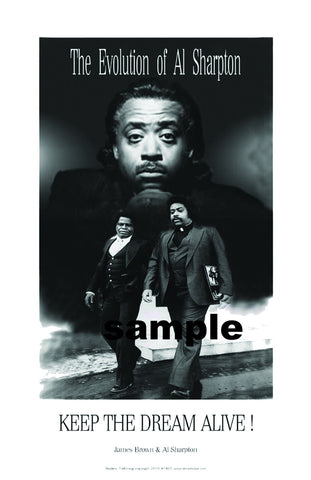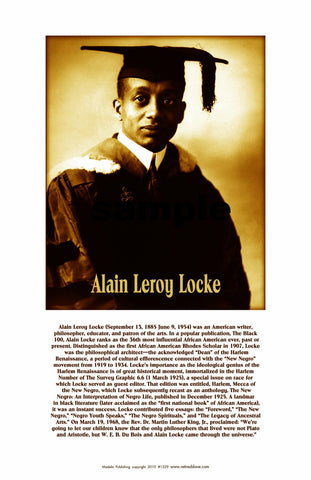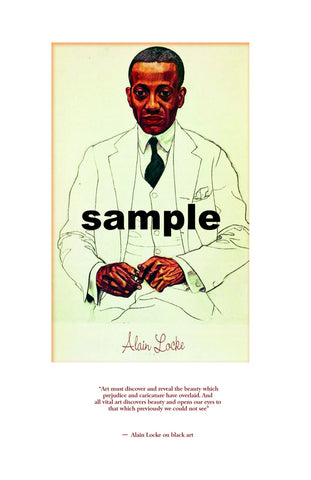Harlem Renaissance #1344
$ 8.00
Caption from poster__
During the Harlem Renaissance The Cotton Club
was one of the most famous nightclubs in history.
The Cotton Club's story points at many reasons why we love the 1920's
and also why the decade has a split personality. Jazz is art of individuals
working in unison to create a sublime sound. Like the rest of the 1920s,
jazz distinguishes itself by being different from the mainstream. Jazz lent
itself perfectly to small nightclubs and speakeasies that dotted Harlem.
Gangster Owen "The Killer" Madden bought the "Club Deluxe" from Jack
Johnson, the former boxing world champion, and renamed the venue The
Cotton Club. Madden was a sharp businessman who had spent 9 years in
Sing Sing prison for the murder of Little Patsy Doyle. As his nickname
suggests, Madden was tough, despite his frail appearance! He was
tough as a man and as a boss. In his younger years, Madden was shot
eleven times at close range by three members of a rival gang, the "Hudson
Dusters." Within a year, Madden had recovered from his wounds and many
the rival gang members were dead. Madden was not a man to mess with.
Madden ruled the Cotton Club, he had no tolerance for screwups and
maintained a white-only customer policy.
and also why the decade has a split personality. Jazz is art of individuals
working in unison to create a sublime sound. Like the rest of the 1920s,
jazz distinguishes itself by being different from the mainstream. Jazz lent
itself perfectly to small nightclubs and speakeasies that dotted Harlem.
Gangster Owen "The Killer" Madden bought the "Club Deluxe" from Jack
Johnson, the former boxing world champion, and renamed the venue The
Cotton Club. Madden was a sharp businessman who had spent 9 years in
Sing Sing prison for the murder of Little Patsy Doyle. As his nickname
suggests, Madden was tough, despite his frail appearance! He was
tough as a man and as a boss. In his younger years, Madden was shot
eleven times at close range by three members of a rival gang, the "Hudson
Dusters." Within a year, Madden had recovered from his wounds and many
the rival gang members were dead. Madden was not a man to mess with.
Madden ruled the Cotton Club, he had no tolerance for screwups and
maintained a white-only customer policy.
During the 1920s and 30s, The Cotton Club was the most famous
nightclub,not only in Harlem, but in all of New York City. Most of
Harlem’s famous musicians played the Cotton Club, from Louis
Armstrong to Duke Ellington, from Ethel Waters to the Bill Robinson.
As well as being a crucible for new musical styles, The Cotton
Club could also be seen as a lightning rod for Harlem history:
although many black stars made their debuts on its stage, the
audience was reserved for whites only. The club was forced to
close after the 1935 riots because it was considered unsafe
for the club’s downtown clientele. The name “Cotton Club” was
conceived by the original owner, mobster Owney Madden, from
the light brown color of raw cotton.Madden hoped to cash in on
the growing Harlem music scene, featuring “Black” entertainment
for an upscale white audience. Madden demanded the girls on his
chorus line be “cotton colored,” or light-skinned Blacks. The Cotton
Club, was itself a black-and-tan fantasy for the whites-only clientele.
The wait staff were all dark-skinned, the chorus line all light-skinned,
as illustrated in the program at right.The club got its name from its
Old South plantation decor. Patrons could imagine themselves back
in a mythic South with black and tan slaves eager to do their bidding.
The show at the Cotton Club was a musical review, loosely based
upon “Ziegfeld’s Follies” and featuring singers, dancers, and
occasional guest stars. There were two performances a night, at
midnight and 2:00. Before and after the midnight show, the orchestra
played dance music for the patrons.
nightclub,not only in Harlem, but in all of New York City. Most of
Harlem’s famous musicians played the Cotton Club, from Louis
Armstrong to Duke Ellington, from Ethel Waters to the Bill Robinson.
As well as being a crucible for new musical styles, The Cotton
Club could also be seen as a lightning rod for Harlem history:
although many black stars made their debuts on its stage, the
audience was reserved for whites only. The club was forced to
close after the 1935 riots because it was considered unsafe
for the club’s downtown clientele. The name “Cotton Club” was
conceived by the original owner, mobster Owney Madden, from
the light brown color of raw cotton.Madden hoped to cash in on
the growing Harlem music scene, featuring “Black” entertainment
for an upscale white audience. Madden demanded the girls on his
chorus line be “cotton colored,” or light-skinned Blacks. The Cotton
Club, was itself a black-and-tan fantasy for the whites-only clientele.
The wait staff were all dark-skinned, the chorus line all light-skinned,
as illustrated in the program at right.The club got its name from its
Old South plantation decor. Patrons could imagine themselves back
in a mythic South with black and tan slaves eager to do their bidding.
The show at the Cotton Club was a musical review, loosely based
upon “Ziegfeld’s Follies” and featuring singers, dancers, and
occasional guest stars. There were two performances a night, at
midnight and 2:00. Before and after the midnight show, the orchestra
played dance music for the patrons.




